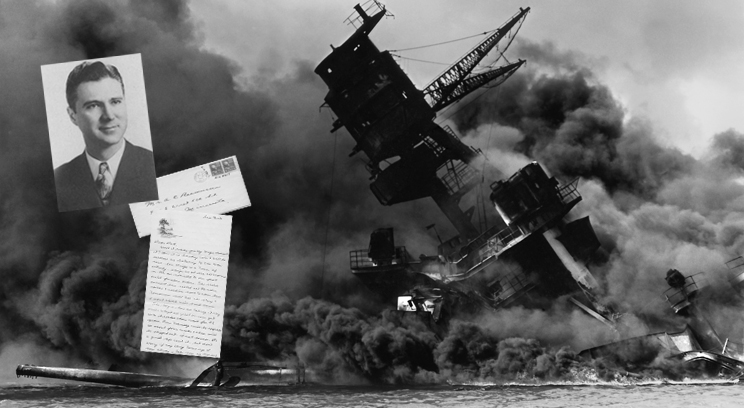“Welcome home!”
To the GI, especially one deployed overseas, no sweeter words can be heard than "Welcome home!" There is, after all, no place like home. Sixty-six years ago Harry Rasmussen – a member of “America’s Greatest Generation” – passed beneath the Summit Avenue arches for the last time. He is home again now, back on campus – at least in spirit – in the form of his Aquinas yearbooks from 1939, 1940, 1941 and 1947, and a historic letter he wrote to his father – on Sunday, Dec. 7, 1941.
That was the day Pearl Harbor was attacked by the Japanese. Addressing Congress the next day, President Franklin D. Roosevelt stated that Dec. 7, 1941, was “a date which will live in infamy.” On that day Rasmussen, who attended St. Thomas for three years before leaving school for the U.S. Army, was stationed at Camp Callan, Torrey Pines, in the San Diego area.
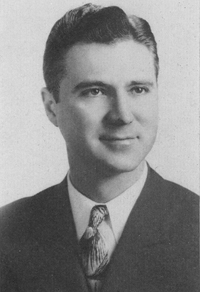
Harry Rasmussen
Senior portrait
Aquinas yearbook, 1947
On Dec. 8, 1941, the U.S. Congress declared war against Japan.
On the evening of that historic Dec. 7, Rasmussen wrote a letter to his father, A.E. Rasmussen, who was living in Winona, Minn. In the upper right-hand corner of the letter he wrote “Sun nite.” The letter’s envelope, which was air mailed with two three-cent, purple, Thomas Jefferson stamps, was postmarked Dec. 8.
The yearbooks contained the letter and other memorabilia and were mailed to the university’s Alumni Association office. Nadiine Friederichs, senior program manager, spotted the letter while paging through the yearbooks.
The letter indicates that Rasmussen was listening to news about Pearl Harbor on a radio. One can only wonder about the thoughts running through his mind as he considered what the future might hold for him and for America.
“I knew that letter was something pretty special and unique because of the timing – when it was written and sent. … With my connection working with our veterans from that period of time, I guess I was more personally affected by it than what someone else might be,” said Friederichs, whose husband (U.S. Marine Corps) and father (U.S. Army, WW II) both served in the military. “I knew that that was a pretty important piece of history.”
The letter
Dear Dad,
Well it looks pretty tough doesn’t it? Here it is Sunday nite & all the soldiers are listening to the war news. San Diego is a town of activity – ships are at sea all around us. We are restricted to our post until further orders. The radio around here called all the Marines, sailors & soldiers back to their base. Tomorrow will tell the story & I don’t think we’ll back down.

Harry Rasmussen wrote this letter on Dec. 7, 1941. A larger image can be viewed at the bottom of this story.
The boys here are taking it very well – they’d all just as soon get into it rather than wait for 2½ years. Our training will be complete in about four weeks & then we’ll be shipped out – if not sooner. It’s a great life isn’t it – but don’t worry if any thing turns up. I can always take care of myself.
Perhaps this letter will be censored. I imagine it will be – & here’s hoping I said nothing wrong.
If things get much worse – I mean actual war – you can forget the camera as it wouldn’t be much use to me.
My room-mate in school last year is here in Cal. someplace & will be shipped to Alaska from here.
Well I’m certainly glad the R.R. didn’t go on strike as it would be rather tough at a time like this.
You’ll read the news in the paper more than I could write – believe some of it but not all –
Take care of yourself & I won’t be seeing you Xmas – but have the car ready as I’d like to take a trip to Rochester sometime.
As Ever,
Harry.
P.S. I’ll bet you – that your ears are glued to the radio right now.

Harry Rasmussen updated his father on what was happening with the 48th Coastal Artillery with this postcard, which was postmarked Dec. 11, 1941.
The postcard
Four days later, on Dec. 11, Rasmussen mailed his father a one-cent-stamp postcard, also featuring Jefferson, noting that troops from the Coastal Artillery were on the move. He wrote:
Dear Dad,
They’re placing them along the west coast. So hard telling where I’ll be. The last bunch went to Wash. Hope they stop there & don’t go to Alaska.
They’re splitting us all up again, just when one makes friends.
You’ll hear from me again – we’re leaving tonite for someplace as new men are already coming in to camp.
Harry.
Rasmussen eventually went on to serve in the Pacific during WW II and stayed in the Army four and a half years, achieving the rank of first sergeant. His last duty was with Headquarters Battery, 48th Coastal Artillery Battalion. He was discharged from the Army in October 1945.
Home to St. Thomas
The yearbooks came home to the university’s Alumni Association through the kindness of sisters Tyrene Jones and Antoinette Freeman. Both live in the San Diego area. Freeman was a caregiver for Doris Rasmussen, Harry’s widow. Doris died Sept. 28, 2010, at age 89. Harry died Sept. 14, 1988, at age 70.
Barry Robin, executor of the Rasmussen estate near San Diego, shed some light on the Rasmussens.
“I knew Harry, certainly, but I didn’t know anything of his past,” remarked Robin, who was married to Doris’ now-deceased daughter by a previous marriage. Harry and Doris had no children.
“Harry was a beautiful man,” Robin added. “Always pleasant. Fairly successful. … Very quiet.”
“Doris saved everything. She was a packrat,” he said. “When Harry passed away they were still very much in love. They are buried next to each other (Riverside National Cemetery).”
The four yearbooks were among the items that were being cleaned out of Doris’ home. Freeman and another caregiver spotted them.
“They just happened to notice these old books,” Robin said. He had no interest in them, and he was not aware of Harry’s letter of Dec. 7, 1941. He believes that no one in the family was aware of it, either.
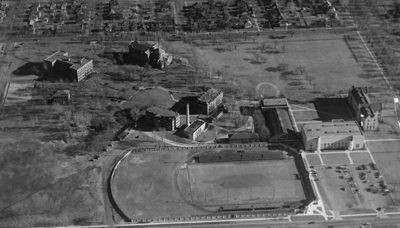
Saturday, Dec. 6, 1941, and all appears quiet on the College of St. Thomas campus in this aerial photograph taken by Carl Baumgaertner '48. Pearl Harbor was attacked the next day. Baumgaertner and pilot George Kell, who had just obtained his private pilot’s license, were students at St. Thomas Military Academy at the time. The academy was located on the campus grounds. See the editor's note below for more information about this photograph.
Freeman passed the books on to Jones, her sister, who collects memorabilia.
“They were just throwing all of these things away, and Ann knew that I like old pictures and I’m interested in these things, so she asked me if I wanted to look at them,” Jones recalled. “I had had them for quite a while and kind of didn’t know what to do with them. I had a lady look up your address for me at a used-book store. So I thought, well, I’m going to send these back hoping that they would mean something to somebody.”
Jones was aware of the letter and postcard, and also a photograph and clippings that were tucked away in the books. She decided to send them, too, as she thought that they also may be of interest.
“I’m just happy. Yes, I’m really happy. That makes me feel good that I got them where they can be put somewhere and not just destroyed,” added Jones, whose father was a tail-gunner in the U.S. Army Air Forces during WW II.
“Handsome Harry”
Who was Harry Rasmussen?
“Handsome Harry,” as one fellow Tommie called him, graduated from St. Mary High School in Sleepy Eye, Minn., in 1936. His high school diploma and a 1934-35 card with the school’s basketball schedule were tucked away in the yearbooks. Rasmussen marked the first eight games of the basketball season with “won.”
Two years later, in 1938, he enrolled at the College of St. Thomas. He attended St. Thomas for three years – from fall 1938 to spring 1941 – and then returned to campus following WW II.
In his first yearbook, the 1939 Aquinas, on Page 1 he wrote:
Harry Rasmussen
Sleepy Eye, Minnesota
St. Thomas College
Ireland Hall Room 105
Based on the comments written by his classmates in the 1939 yearbook, Rasmussen was well-liked, well-known as a “swell fella” and something of a free spirit. He was described as: a “Sleepy Eye flashie,” by Emmett Hoffman; “a good entertainer on a streetcar,” by Paul Greving; “a guy who can really sling the bull,” by Thos. B. Brady; and “a guy who played checkers when he shouldn’t,” by Tim Murphy.

In the 1940 Aquinas, “Bernie” Fridell wrote a note to Harry Rasmussen: “Well Harry – Here’s one to you!! Certainly hope to see you & Ray [?] at the same spot next year.”
In the 1940 Aquinas classmates again noted that Rasmussen was a “swell guy” and “one of the swellest fellas” several times. On the lighter side: “To a good judge of wine, women and song. I hope you’re back next year, Harry,” wrote Darrell Daudell; “Harry, the official inspector of all liquid amusement establishments,” noted Carl Putz; “Here’s wishing lots of luck to a swell fellow, and a good room-mate, and I especially hope that the dice will always roll good for you on the old ‘14’ board,” wrote Art Mauer.
Rasmussen also commented in his 1940 Aquinas: “Another successful year.”
The looming war
By 1941, a looming war was affecting college campuses. In the activities section of the 1941 Aquinas, students are pictured taking flight training offered by the Civil Aeronautics Authority, known as the C.A.A. The yearbook noted: “Although this training is indirectly part of the huge national preparedness campaign there is no obligation attached to the students who complete the course.”
Based on classmates’ notes written in the 1941 Aquinas, Rasmussen apparently was drafted and entered the service after spring semester. The comments took on a more somber tone than in previous years: “See you in the Army,” wrote Jim McGuire and several others. “Harry, you’ll pick up more ‘Philosophy’ in the Army than you do here. I’ll see you there in about a year,” wrote Bill Scherkenbach. “Best of luck, Harry. You’re too good a man to be drafted,” wrote John Campbell. “Lots of luck, Harry, see you in the Army. Your pal, Tom Feely.”
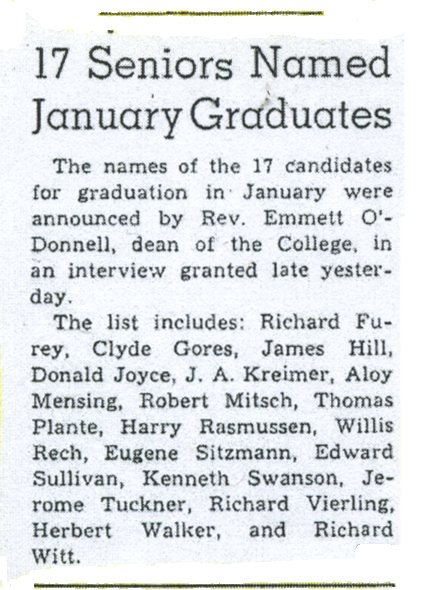
In this clipping dated, ironically, Dec. 6, 1946, from The Aquin, the student newspaper at the time, Harry Rasmussen was listed as one of 17 seniors who was to graduate in January, 1947.
“Harry, you’ve helped me thru thick and thin and boy I’ll never forget it – you deserve a break – and if it could come from me you’d be at the top of the list. Luck,” ~Johnny Slapsy Krause
“Good luck in the Army, Harry, I suppose I’ll see you soon,” wrote Bob Winterer.
The Aquinas, 1947
Not one comment was written in Rasmussen’s 1947 Aquinas, likely because yearbooks traditionally came out in the fall to accommodate sports from the previous spring.
St. Thomas records do not indicate that Rasmussen graduated, but he is pictured in the 1947 yearbook with this caption: “Harry J. Rasmussen, Sleepy Eye. B.A. in Social Science. War service, army, 4½ yrs., Pacific, 1st sgt. Plans business.” In a story published, ironically, on Dec. 6, 1946, in The Aquin, the student-run campus newspaper, he is listed among “17 Seniors Named January Graduates.”
Rasmussen was one of 100 students with senior portraits in the 1947 yearbook. Eight-five of them served in the armed forces during WW II. Among those 100 was John T. Coskran, Mr. Tommy of 1944. Almost all of the pictured veterans served three or more years.
“We shall succeed”
Included with the class of ’47 portraits was a poignant editorial note titled “Class of 1947 Leaves St. Thomas.” It stated:
Thanks to World War II, the group that is graduating as the Class of 1947 is probably as varied as any class that will ever leave St. Thomas. … These are the seniors whose education was delayed two to five years and still think of themselves as members of classes that have long since graduated. …
A history of the Class of ’47 would be a history of individuals for we have hardly been together long enough to have a group history. …
It is safe to say that we are older, wiser, and more mature than any other graduating class since the first few years following World War I. We are anxious and eager to leave College and begin to seek our place in the world which has left us behind. Can we catch up? If application and study mean anything, the faculty is as one in agreeing that we shall succeed.
That they did.
“Welcome home, 1st Sgt. Harry Rasmussen!”
* * *
Editor's note: For more information about Carl Baumgaertner's aerial photograph taken on Dec. 6, 1941, see My View at 1,000 Feet.
* * *
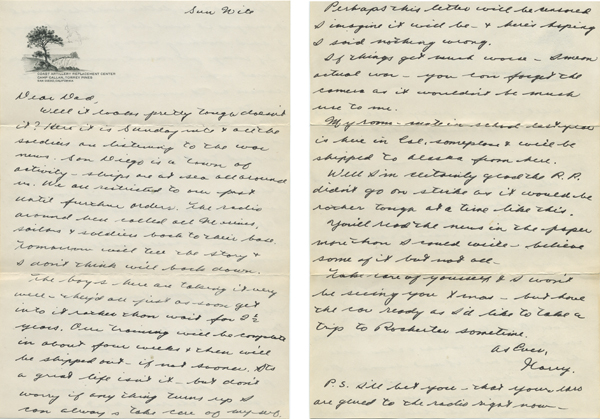
This is the letter Harry Rasmussen wrote following the attack on Pearl Harbor, Dec. 7, 1941.
